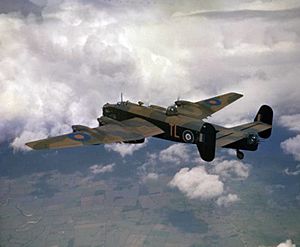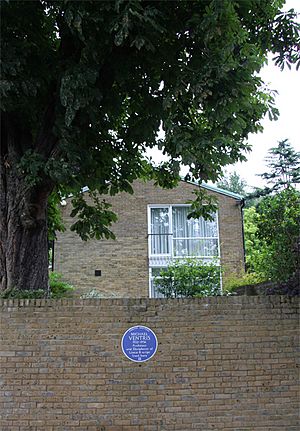Michael Ventris facts for kids
Quick facts for kids
Michael Ventris
|
|
|---|---|
 |
|
| Born |
Michael George Francis Ventris
12 July 1922 Wheathampstead, Hertfordshire
|
| Died | 6 September 1956 (aged 34) Hatfield, Hertfordshire
|
| Nationality | British |
| Education | Architectural Association School of Architecture |
| Occupation | Architect |
| Known for | Decipherment of Linear B |
| Spouse(s) | Lois "Betty" Ventris (née Knox-Niven, 1920–87) |
| Children | 2 |
| Relatives | Francis Ventris (grandfather) |
| Awards |
|
Michael George Francis Ventris was a smart English architect and language expert. He is famous for figuring out Linear B. This was an ancient writing system used by the Mycenaean Greek people. Michael Ventris loved languages and worked on solving this mystery since he was a teenager.
He created a whole new area of study with his discovery. Sadly, he died in a car accident when he was only 34. This happened just weeks before his important book, Documents in Mycenaean Greek, was published. He wrote this book with his friend John Chadwick.
Contents
Early Life and Learning
Michael Ventris was born on July 12, 1922. His family had a history in the army. His grandfather was a major-general. His father was also in the army but retired early because he was sick. Michael's mother, Anna Dorothea Janasz, came from a rich Polish family. Michael was their only child.
The family moved to Switzerland for eight years. They hoped the healthy environment would help his father. Young Michael went to school in Gstaad. Classes there were taught in French and German. He quickly became fluent in both. He was also good at Swiss German. Michael could learn a new language in just a few weeks. He became fluent in about twelve languages! His mother often spoke Polish to him, and he knew it well by age eight. At this young age, he was already reading books about ancient Egyptian writing.
In 1931, Michael's family returned to England. He went to Bickley Hill School and then to Stowe School. At Stowe, he learned some Latin and Ancient Greek. He spent most of his free time studying Linear B. He would even read about it under his covers at night with a flashlight!
When he was not at school, Michael lived with his mother. They lived in modern apartments in London. His mother knew many artists and writers. Their home was filled with modern art.
Becoming an Adult
Michael's father died in 1938. His mother lost her money when Germany invaded Poland in 1939. A family friend, the Russian artist Naum Gabo, helped Michael. Michael later said Gabo was like family to him. It might have been at Gabo's house that he started learning Russian.
Michael decided to become an architect. He joined the Architectural Association School of Architecture. There, he met Lois Knox-Niven, who he called Betty. She was also studying architecture. Her family was wealthy, and she had traveled a lot. She was also very popular.
Michael did not finish his architecture studies right away. He joined the Royal Air Force (RAF) in 1942. He chose to be a navigator. He trained in the UK and Canada. In 1944, he became an officer. He also studied Russian very hard during his training.
He flew in bombing missions over Germany. He was part of No. 76 Squadron RAF. After the war, he stayed in Germany because he knew Russian. People thought he might be working in intelligence, but there is no proof of this. He was also not part of any secret code-breaking team, even though many people believed he was.
Architect and Ancient Script Expert
After the war, Michael worked for a short time in Sweden. He learned enough Swedish to talk with scholars there. Then he came home and finished his architecture degree in 1948. He started working as an architect. He designed schools for the government.
He and his wife, Lois, designed their own family home in London. Michael and Lois had two children: a son named Nikki (born 1942) and a daughter named Tessa (born 1946).
Michael kept working on Linear B in his spare time. In 1952, he made an amazing discovery. He found out that Linear B was actually an old form of Greek!
Solving the Mystery
In the early 1900s, an archaeologist named Arthur Evans was digging at an ancient site. This site was called Knossos, on the island of Crete. He found many clay tablets with two unknown writing systems. These were called Linear A and Linear B. Evans tried to figure them out for many years but had little success.
In 1936, Evans had an exhibition in London. It was about ancient Crete. Michael Ventris, who was 14 years old, attended a lecture given by Evans. Michael remembered Evans walking with a special cane. During the lecture, Evans showed the tablets with the unknown scripts. Michael quickly learned that Linear B had not been solved yet. He decided right then that he would be the one to decipher it.
In 1940, when he was 18, Michael Ventris wrote an article. It was called "Introducing the Minoan Language." He first thought that Linear B was related to the Etruscan language. He believed this might help him solve it. This idea turned out to be wrong, but he kept exploring it for many years.
Soon after Evans died, another scholar named Alice Kober noticed something important. She saw that some words in Linear B changed their endings. This was like how words change in Latin or Greek. Michael Ventris used this clue. He made special charts to connect the symbols on the tablets with consonants and vowels. He still didn't know which sounds they were. But he learned enough about the language's structure to start guessing. Kober's work was very important to his own discoveries.
Before World War II, an American archaeologist named Carl Blegen found more than 600 Linear B tablets. He found them at an ancient palace in Pylos, Greece. Pictures of these tablets helped Ventris a lot later on.
In 1948, Sir John Myres asked a group of experts to help him copy Linear B texts. Alice Kober and Michael Ventris were both part of this group. Kober's work gave Ventris the basic understanding he needed.
On July 1, 1952, Ventris shared his first findings on a BBC radio show. John Chadwick, a language expert from Cambridge University, heard the talk. Chadwick had worked on breaking codes during World War II. The two men decided to work together.
In 1953, more Linear B tablets were found in Greece. One tablet showed pictures of tripod cauldrons. These pictures matched the symbols that Ventris and Chadwick had translated. This was a huge breakthrough! It led to more people working together. Between 1953 and 1956, Ventris and Chadwick published papers together.
Ventris compared the tablets found on Crete with those from mainland Greece. He noticed that some groups of symbols only appeared in the Cretan texts. He made a smart guess: these must be place names on the island of Crete. This guess was correct! With these place names, he could figure out more symbols. Soon, he unlocked much of the text. He proved that Linear B was an ancient form of Greek.
This discovery changed what people thought about ancient Cretan history. It showed that the Cretan civilization, at least during the time of the Linear B tablets, was part of Mycenaean Greece.
Death and Lasting Impact
In 1955, Michael Ventris received an award called the OBE. This was for his great work on ancient Greek writing.
In 1956, Ventris died instantly in a car crash. He was driving home late at night in Hatfield, Hertfordshire. He was only 34 years old. The police said it was an accidental death. In 1959, he was given another award, the British Academy's Kenyon Medal, after his death.
There is a special English Heritage blue plaque on his home in London. It remembers his achievements. A street in Heraklion, the capital of Crete, is also named after him.
In 1970, a crater on the far side of the Moon was named in his honor. This was done by the International Astronomical Union.
See also
 In Spanish: Michael Ventris para niños
In Spanish: Michael Ventris para niños
- Emmett Bennett




